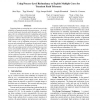242 search results - page 2 / 49 » Computing bounds for fault tolerance using formal techniques |
TSE
1998
13 years 5 months ago
1998
An important step in the development of dependable systems is the validation of their fault tolerance properties. Fault injection has been widely used for this purpose, however wi...
ESCIENCE
2007
IEEE
13 years 11 months ago
2007
IEEE
The emergence of computational grids has lead to an increased reliance on task schedulers that can guarantee the completion of tasks that are executed on unreliable systems. There...
FDTC
2006
Springer
13 years 9 months ago
2006
Springer
With physical attacks threatening the security of current cryptographic schemes, no security policy can be developed without taking into account the physical nature of computation....
ICC
2007
IEEE
13 years 11 months ago
2007
IEEE
In this paper we investigate the fault diagnosis problem in IP networks. We provide a lower bound on the average number of probes per edge using variational inference technique pro...
DSN
2007
IEEE
13 years 11 months ago
2007
IEEE
Transient faults are emerging as a critical concern in the reliability of general-purpose microprocessors. As architectural trends point towards multi-threaded multi-core designs,...

